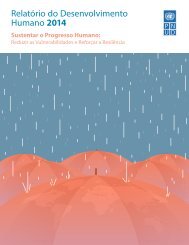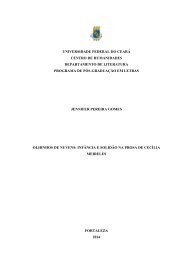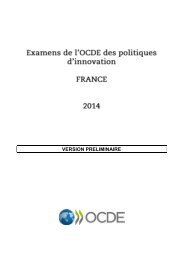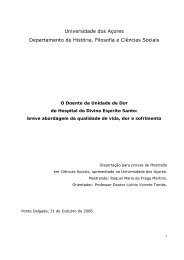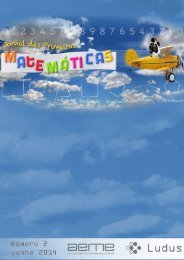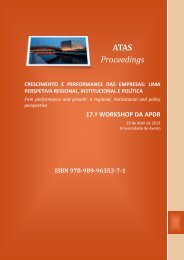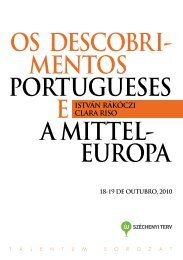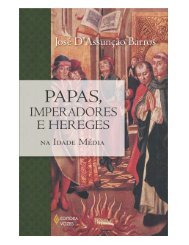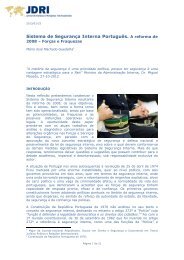1POTXAdSn
1POTXAdSn
1POTXAdSn
You also want an ePaper? Increase the reach of your titles
YUMPU automatically turns print PDFs into web optimized ePapers that Google loves.
notas explicativas<br />
Os nemátodes são um grupo de invertebrados, não<br />
segmentados que formam um filo (Nematoda) bem<br />
definido e claramente distinto dos outros grupos de organismos.<br />
Este filo constitui um dos grupos animais<br />
mais disseminados no planeta, e em termos de número<br />
de indivíduos, os nemátodes são o grupo animal mais<br />
abundante na Terra: quatro em cada cinco animais da<br />
biosfera são nemátodes. Apesar de microscópicos, os<br />
animais multicelulares que constituem este grupo são<br />
capazes de explorar uma enorme variedade de habitats,<br />
nos mares, nas águas doces, nos solos, bem como<br />
parasitas de animais ou de plantas, ou mesmo em condições<br />
extremas, como nos solos secos da Antárctida<br />
ou em fontes termais (Baldwin et al. 1999).<br />
A actual informação sobre a nematofauna do arquipélago<br />
dos Açores encontra-se fraccionada e espalhada<br />
em diversas publicações científicas, mas também<br />
em dados ainda não publicados (Sturhan, comunicação<br />
pessoal). Entre as diversas publicações de nemátodes<br />
para os Açores, há que salientar os trabalhos<br />
realizados por Sturhan (1973, 1975, 1983) e Macara<br />
(1994), que muito contribuíram para o conhecimento<br />
da distribuição actual das espécies de vida livre e parasitas<br />
de plantas; bem como os trabalhos de Afonso-<br />
Roque (1995) e Casanova et al. (1996) relativamente<br />
a espécies parasitas de animais, reportadas para as diferentes<br />
ilhas do arquipélago.<br />
A lista de nemátodes apresentada neste capítulo tem<br />
base as publicações conhecidas para o arquipélago (ver<br />
listagem de publicações até 2010 em www. naturdata.<br />
com), bem como o registo de espécies assinaladas pela<br />
primeira vez para o arquipélago (Sturhan, comunicação<br />
pessoal). A classificação utilizada baseia-se na recente<br />
revisão da sistemática e filogenia proposta por De Ley<br />
& Blaxter (2002) para todo o filo, até ao nível da família.<br />
A classificação dos restantes taxa segue o critério utilizado<br />
para a fauna terrestre da “Fauna Europaea” (http://<br />
www.faunaeur.org). É apresentada a distribuição das espécies<br />
nas nove ilhas dos Açores, usando-se a seguinte<br />
simbologia: COR – Corvo; FLO – Flores; FAI – Faial;<br />
PIC – Pico; GRA – Graciosa; SJG – São Jorge; TER –<br />
Terceira; SMG – São Miguel e SMR – Santa Maria.<br />
A primeira coluna (D) refere-se ao estatuto de colonização<br />
de cada espécie:<br />
158<br />
explanatory notes<br />
Nematodes are a group of non-segmented invertebrates,<br />
which constitute a well defined phylum (Nematoda)<br />
distinct from other animal groups. This phylum is one of<br />
the most disseminated group of animals in the planet and<br />
the most abundant: it is estimated that four out of every<br />
five animals in the biosphere are nematodes. Despite<br />
being microscopic, these multicellular animals are<br />
capable of exploring a wide variety of habitats including<br />
oceans, fresh waters, soils, animals and plant, and even<br />
extreme environments such as dry soils in the Antarctica<br />
or thermal vents (Baldwin et al. 1999).<br />
Present information regarding the nematode fauna<br />
of the Azores archipelago is fractioned and spread<br />
throughout diverse scientific publications, but also in<br />
non-published data and reports (Sturhan, pers. comm.).<br />
Among the different publications on nematodes of<br />
the Azores, special focus should be given to those<br />
by Sturhan (1973, 1975, 1983) and Macara (1994)<br />
which have greatly contributed to the knowledge and<br />
present distribution of species of free-living and plant<br />
parasites; the same should be said about the works of<br />
Afonso-Roque (1995) and Casanova et al. (1996), in<br />
relation to species of animal parasites, reported for the<br />
different islands.<br />
The list of nematodes presented in this chapter is<br />
based on known publications for the archipelago (see<br />
list of publications up to 2010 in www. naturdata.com),<br />
as well as the record of species reported for the first<br />
time (Sturhan, pers. comm.). Classification is based on<br />
the recent revision of the systematics and phylogeny<br />
proposed by De Ley & Blaxter (2002) for the entire<br />
phylum, up to family level. Classification of other taxa<br />
follows the criteria used for terrestrial fauna in “Fauna<br />
Europaea” (http://www.faunaeur.org). The distribution<br />
of species from the nine islands is presented, and using<br />
the following symbols: COR – Corvo; FLO – Flores;<br />
FAI – Faial; PIC – Pico; GRA – Graciosa; SJG – São<br />
Jorge; TER – Terceira; SMG – São Miguel and SMR<br />
– Santa Maria.<br />
The first column (D) refers to the colonization<br />
status of each species:<br />
end – species endemic to the azores, i.e<br />
species occurring only in the Azores as a result of<br />
local evolutionary speciation (neo-endemisms) or





